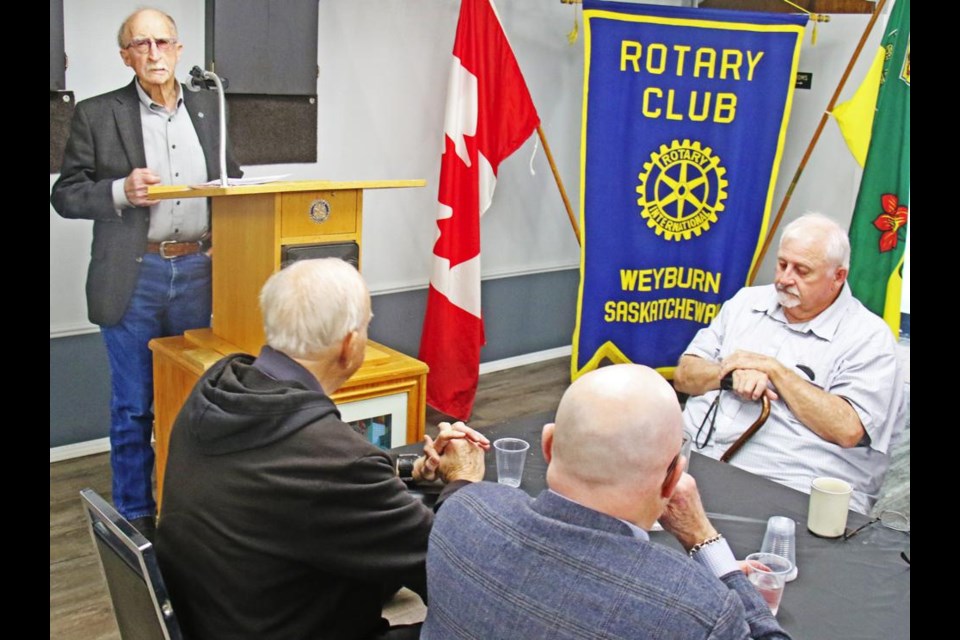WEYBURN – A lifelong rancher from the Radville area, Murray McGillivray, shared his love of Saskatchewan and of the cattle industry in a presentation to the Weyburn Rotary Club on Thursday.
His family has long had a historical connection to the Weyburn area, as he noted his grandfather’s younger brother Jim practiced medicine in Weyburn for over 40 years, and his sister Sadie taught school here for many years.
His father farmed north of Weyburn for most of his life, and Murray started in the ranch business in 1958.
“It always bothers me that we don’t talk enough about Saskatchewan in a positive way,” he said, pointing out this province has 160.9 million acres from border to border, and 64 million acres of arable land, more than Alberta and Manitoba put together.
Out of the total arable land area, about 22.2 million acres has forage and native prairie grass, which is the basis of support for the cattle industry in the province, he said, enabling Saskatchewan to have the second largest herd in Canada, behind only Alberta.
“I’m told there are 100 varieties of native grass. It’s such a huge resource for the province of Saskatchewan,” said McGillivray, noting a large part of his ranch has native grass in the same state as it was a century ago.
As he got involved in the cattle industry, he was encouraged to become involved in the Saskatchewan Stock Growers Association, and in November of 1970, he was elected to the board of directors.
McGillivray recounted how he and the late Boyd Anderson (who was president of the association at the time) traveled together to Ottawa to lobby the government on various issues relating to the cattle industry.
“He took me under his wing and mentored me. I admired hi8m, his attitude and technique,” he said, noting the stated purpose of the Stock Growers group was to represent the livestock industry to the government.
“There are some governments that are friendly to us, some that are so-so, and then there are some that are slightly adverse to us,” said McGillivray, noting the Blakeney government was one of those he would describe as adverse to the industry.
One of the changes made was to go against 60 years of tradition established for ranch land, and allow Crown land to be posted for anyone to buy. The result was, a rancher could lose the use of a section of land in the middle of their ranch property, and this ended up stopping the sale of ranch land altogether.
Up until this time, someone could buy your ranch land, and if it included deeded Crown land, it was turned over to the rancher and they were then responsible for the taxes on the land.
As a member of the Stock Growers board, he and Anderson went to the government to lobby for a change to the policy, and McGillivray noted he learned a lot about the lobbying process from these trips.
Among the lessons was the proper procedure for approaching the government.
“For example, you never take more than two people with you, and be careful who you take. Some people get too wound up and lose their emotions. We always went with a suit and tie, and always addressed the minister as ‘mister’, without exception. Also, you have to go back a number of times, and have your facts and be factual. We can present alternatives and so on, but don’t expect an answer on the first half hour or 20-minute visit,” he explained, noting even after presenting the facts they still met with politicians who would not change their minds on a set policy.
McGillivray noted that Saskatchewan’s cow herd is down to about a million head now because of lower profitability for ranchers, as he pointed out there’s a difference of about $27 an acre in profitability between a grain operation and a ranch.
“So, do the math. On a 2,000-acre operation, that’s over $50,000, and lentils grows good on dry land,” he said.
Another challenge facing the industry right now is a lack of skilled labour.
“There is a way to handle cattle, and a way not to handle them. I can gather 270 cows and calves by myself, a good dog and my wife, but once you get them into the corral, that’s when you need people in there to help you,” said McGillivray.
“It’s causing us as an industry some concern, and the concern is it will put pressure on us, because any operation needs the tame grass, and ideally the native grass,” he said, noting some formerly good ranch land is now going over to grain instead.






